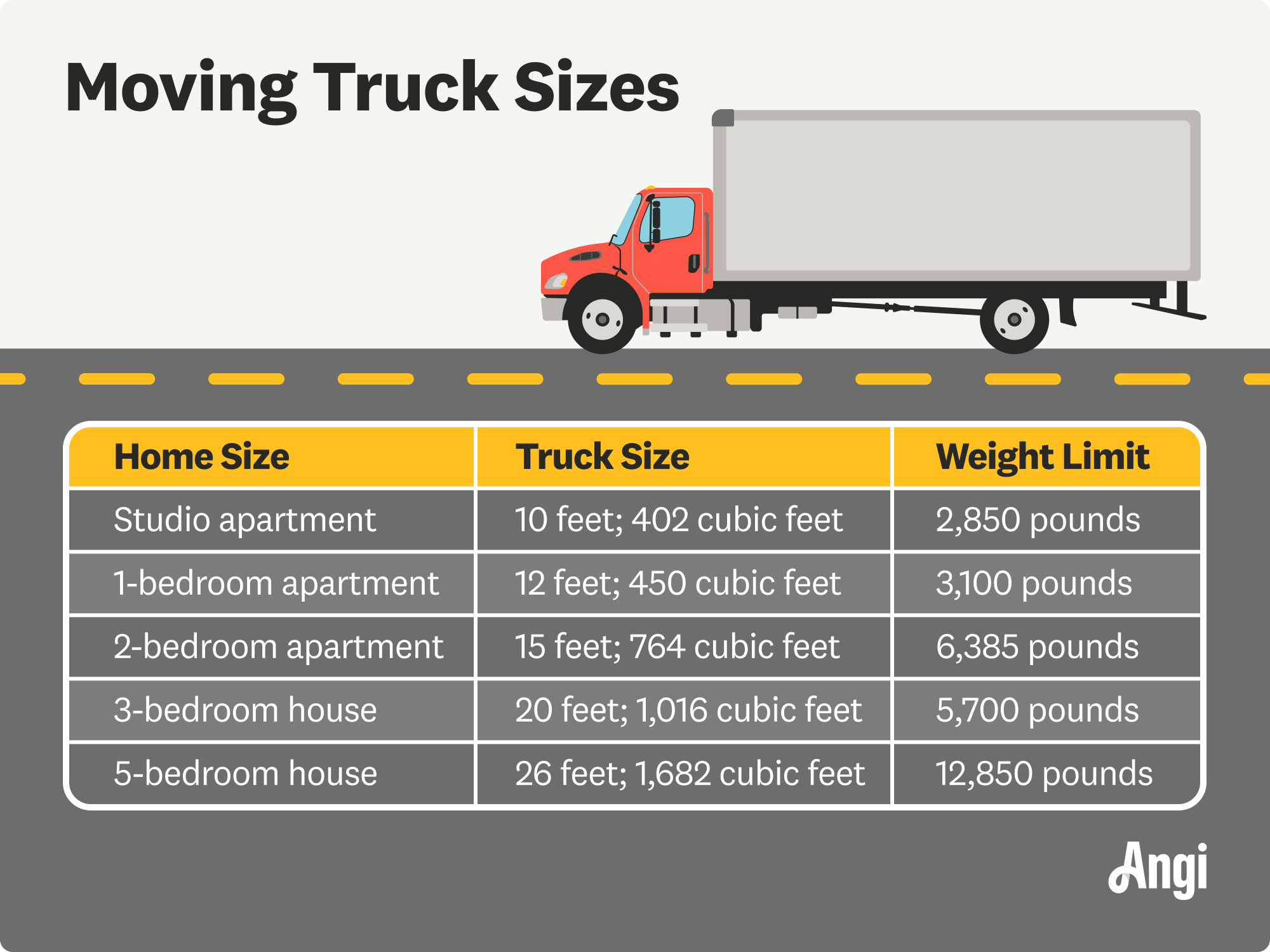
The cost to move a tiny house depends on its weight, distance, and what type of moving equipment is required. Our guide can help you budget for your move.
Measure once and calculate twice to find the best moving truck size


To figure out how big of a moving truck you need, determine the size of your home first.
Measure big pieces of furniture and tally how many boxes you’ll have.
Use a moving calculator to determine how much cubic space you’ll need.
Compare your cubic space with the capacity of the moving truck for the best fit.
If you’re wondering, “How big of a moving truck do I need?” you’ve come to the right place. The worst-case scenario is renting a moving truck to carry your household items to your new home, but when you start loading it on moving day, you realize there isn’t enough space to fit all your boxes. This headache-inducing situation is why choosing the right size moving truck rental is essential.
To ensure that you don’t end up with a moving truck that’s too big or too small, use this guide to determine which size fits your moving needs.
Calculations are based on a long-distance move of a two-bedroom apartment, which is about 6,000 pounds of belongings. Calculations rounded to the nearest whole number.
| Size Factor | Average Measurement |
|---|---|
| Size of space | 2-bedroom apartment |
| Weight of belongings | 6,000 pounds |
| Distance traveling | 500 miles |
| Suggested moving truck size: | 15 feet; 764 cubic feet |
To calculate the best moving truck size for your move, follow these steps:
Measure your space: Most moving truck companies determine sizing by the number of rooms in your current home. For example, moving out of a one-bedroom apartment requires a smaller truck than transporting belongings from a four-bedroom house.
Calculate the weight of your belongings: Some moving companies base truck size on the weight and size of your items. Be sure to include furniture pieces and estimated weight of moving boxes.
Consider the distance: Some moving truck companies consider the total distance being traveled in the truck choice, so specify the number of miles when getting quotes.

Many moving truck sizes are available, from 10-foot options that can transport everything inside a small studio apartment to whopping 26-foot trucks that can hold over 12,000 pounds. The right moving truck size for your move depends on the size of your current space and how many rooms you occupy. It’s also important to consider cubic feet when packing a moving truck, which is the measurement of the interior space inside the truck. This detail will determine whether your items will fit in one truck or if you need backup vehicles to store the items that don’t fit.
Generally, small box trucks in the 10-foot to 12-foot range are best for small spaces, such as studios or 1-bedroom apartments, while medium trucks in the 12 to 15-foot range are better for larger apartments with multiple bedrooms. Medium box trucks are usually too small for homes with several bedrooms unless you don’t own any oversized furniture. Large moving trucks in the 20-foot to 26-foot range are best suited for larger homes with up to five bedrooms.
| Size of Space | Suggested Truck Size | Weight Limit |
|---|---|---|
| Studio apartment | 10 feet; 402 cubic feet | 2,850 pounds |
| 1-bedroom apartment | 12 feet; 450 cubic feet | 3,100 pounds |
| 2-bedroom apartment | 15 feet; 764 cubic feet | 6,385 pounds |
| 3-bedroom house | 20 feet; 1,016 cubic feet | 5,700 pounds |
| 5-bedroom house | 26 feet; 1,682 cubic feet | 12,859 pounds |

They say measure once and cut twice for a reason, and the same idea goes for selecting a moving truck. The steps below can help you find the most accurately sized moving truck for your needs.
The first step in choosing the right moving truck is to learn the exact measurements and size of your home, either in square footage or in rooms. This data will give you and your moving company a better idea of how big a moving truck you’ll need.
For example, a 500-square-foot studio apartment will likely need one 6-foot truck, while a five- bedroom house will need a larger truck, somewhere around 25 feet.
Once you’ve made note of the size of your space, it’s time to take a look at what items you’re taking with you. Large pieces of furniture, such as sectional couches, refrigerators, and heavy hutches, will take up more room in a moving truck than a headboard and a bed frame. Measure these items to keep track of the total cubic feet they’ll take up in the moving truck.
Then, estimate how many moving boxes you’ll need for all other household items, like clothing, dishes, and more. Be sure to track the number of boxes and the size of each one to determine how much space you’ll need for them.
Now that you’ve figured out the size of your home and how much stuff you’re taking with you, you can plug the details into an online moving calculator to get an estimate on the truck size that will work best. Once you provide a tally for everything you’re taking with you—and we mean everything, from lawn mowers to TV stands—the calculator will come up with a measurement in cubic feet that you can then compare with different moving truck sizes.
After figuring out how much cubic feet you’ll need to store your items, experts recommend that you book a truck with about 10% to 15% more cubic space. This ensures you have plenty of room for all of your belongings; that way, you can avoid any last-minute scrambling if your favorite recliner can’t squeeze in.
The type of moving truck that’s best for you also varies by model, since some are best for a few bulky items while others can haul a massive amount of boxes and furniture.
This option is mainly for moving a small number of items or a few bulky pieces of furniture. If you only need to move a small apartment’s worth of furniture, a pickup truck is an inexpensive alternative to renting a larger moving vehicle. Transport your large pieces of furniture, such as your mattress or kitchen table, in the pickup truck and move smaller boxes and household items in your car.
A cargo van is the next step up from a pickup truck. While the dimensions of your cargo van will depend on the rental company, they are typically ideal for small apartment or home moves. Plus, cargo vans tend to be easier to drive and park than a large box truck, which is a lifesaver during the moving process.
When you picture a moving truck, a box truck is probably what comes to mind. This moving vehicle is commonly used for long-distance moves and transporting larger loads.
The dimensions of box trucks vary by moving truck rental company, but they typically run in small, medium, and large sizes. Small box trucks are ideal for one- or two-bedroom apartment moves, but they don’t usually hold king-sized mattresses. Mid-size options offer a lot more space, with most ranging from 15- to 17-foot box trucks. The largest box trucks can carry the largest weight and load, including California king mattresses and even a washer and dryer set.
| Number of Bedrooms | Recommended Box Truck Size |
|---|---|
| One | 10-foot box truck |
| Two | 15- or 16-foot box truck |
| Two–Three | 18-foot box truck |
| Three | 20- or 22-foot box truck |
| Four | 26-foot box truck |
Once you’ve settled on the type of moving vehicle you want to rent, the next step is to budget for its cost. The average cost of renting a moving truck is $1,000, with most movers charging $1 to $2 per mile. The final price tag will depend on the size of the rental vehicle and the number of miles traveled, and the costs vary by the rental company.
For example, a local move out of a one-bedroom apartment can cost as low as $130, while a large, long-distance move can cost more than $2,000. Plus, keep in mind that you’re responsible for paying for the rental vehicle’s gas, insurance, and additional supplies. If you need help loading the moving truck, call a moving company near you so you can focus on preparing to move into your new home.
From average costs to expert advice, get all the answers you need to get your job done.

The cost to move a tiny house depends on its weight, distance, and what type of moving equipment is required. Our guide can help you budget for your move.

How much do hot tub movers cost? Find out the average prices for professional hot tub movers, whether you’re moving it on your property or to a new home.

Whether you need to ship a moving container overseas or domestically, you can expect to pay several thousands of dollars. Learn more using our cost guide.

With some extra planning, moving during the cold season is worth the hassle. Find out why winter can be the best time to move and how to do it successfully.

You’ve just moved into a new home and aren’t sure which projects to tackle first or what can wait. Read on for advice on the to-dos you should take on initially.

Moving a gun safe requires specialty equipment and transportation. Learn seven tips to ensure that moving your gun safe goes as smoothly as possible.